|
Tour 1
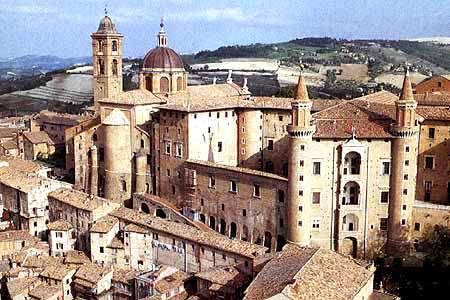
Urbino
The Castles of Montefeltro
The gentle mountains in the far northern corner of the Marche provide the backdrop to this tour of the lands once ruled over by the medieval lords of Montefeltro. Centred on the magical city of Urbino, one of Italy's most alluring Renaissance towns, the route takes in a string of imposing hill towns crowned with impregnable fortresses, set in ever-changing and breathtaking countryside.
You'll find the most imposing of these ancient strongholds at San Leo.
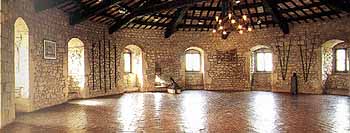
Interno della Rocca - San Leo
But many of the less famous castles on the way, such as Sassocorvaro and Sant'Agata Feltria, will impress you by their understated elegance and you will soon learn to recognise the hand of one of Renaissance Italy's greatest military architects, Francesco di Giorgio Martini. For it was he who either built or extensively remodelled many of them in the 15th century during the rule of Federico da Montefeltro, the greatest of Urbino's dukes.
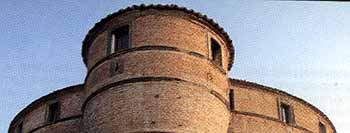
Rocca Ubaldinesca - Sassocorvaro
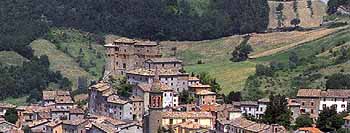
S.Agata Feltria
But the tour has other charms alongside the castles. Lovers of wild countryside will enjoy the high slopes of Monte Carpegna that contrast well with the softer hills on the earlier parts of the route. A traditional style of farming is still practised in much of the area and the landscape remains relatively unscathed by industry. Each of the small towns on the route has its particular appeal, perhaps none so much as Pennabilli with its narrow medieval streets and lovingly restored buildings.
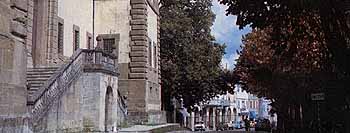
Carpegna
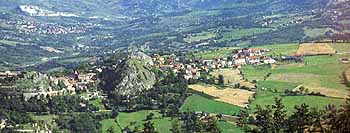
Pennabilli
The pleasures of the table are also well represented along the way. Carpegna is famous for its prosciutto crudo, or raw, cured ham - coscia, sale, tempo e nient'altro (thigh, salt, time and nothing else) as its publicity states. The pecorino sheep's cheeses are excellent in much of the area and in the northern reaches you will find the much prized formaggio di fossa, a strong-flavoured cheese matured in sealed-up caves; try it with a dab of the proper local honey. Truffles, or tartufi, also feature on the menu in the area, although for the best fresh white and black truffles you'll need to visit in the winter. The beech woods of the area also produce a good crop of funghi porcini, the king of edible wild mushrooms.
The Route
Part I - Urbino to San Leo
The journey starts from Urbino on its twin-peaked hill. Slow, twisting minor roads lead to the first stop at Sassocorvaro. Apart from a pretty setting beside an artificial lake, there is one overriding reason to visit this homely village - to see its splendid castle, which sits like a giant tortoise in the central square. Designed in 1475 by Francesco di Giorgio Martini for the powerful local Ubaldini family, it is reckoned one of his finest works.
Winding along the valley of a rushing torrent the road now heads for Macerata Feltria. This small place has a modern part, noted for its spa establishment and the more interesting medieval bit, castello, up above, around the old castle. The 14thC church of San Francesco with a pleasing Gothic portal is worth looking out for while you stroll around.
From here our route takes you along roller-coaster roads with glorious views towards San Leo. Pause for a while at Pietrarubbia to admire atmospheric rocky outcrops and the small hamlet, once abandoned and now restored with singular good taste.
Part II - San Leo to Carpegna
From afar the rocca, or ancient castle of San Leo seems unreachable, perched up above sheer cliffs. Modern road engineering, however, takes you up with no problem. As well as the fortress, San Leo has a pair of remarkable early Romanesque churches.
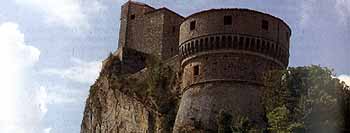
La Rocca di San Leo
From San Leo our route heads off on a switchback journey to Sant'Agata Feltria. On the way, turn off to visit Talamello, a small village which is famed for its formaggio di fossa, a cheese walled up in tufa rock caves to mature for months - a taste is a must for anyone who takes their cheeses seriously.
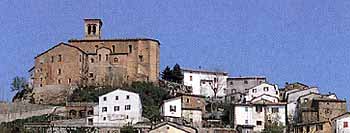
Talamello
In the village of Sant’Agata Feltria there stands another outstanding castle that bears the stamp of Francesco di Giorgio Martini. The original Rocca Fregoso dates back to the 11th century, but was much remodelled by Giorgio Martini who added the two polygonal ramparts. The museum inside houses a collection of rare manuscripts dating back to the 15th century.
From Sant'Agata Feltria the next port of call is affable Pennabilli. Set in a natural amphitheatre, this old town makes a great base to explore the surrounding wild countryside. In recent years it has also acquired a certain fashionable status as a summer resort with many newcomers buying and doing up town apartments and local farmhouses. Its name comes from the union of the two castles that top the town's two peaks - Penna and Billi. You can still see their ruins today. Although a lot of the town has been heavily restored (the price for its fashionable status) it has all been done in the best possible taste and you can happily spend a couple of hours exploring its winding up-and-down streets. Its other great plus, standing at 630 metres above sea level, is a cool climate - a great break in high summer from the heat of the coastal plain. For most of July it hosts a celebrated antiques fair with exhibitors from across Italy and abroad. There are also a host of other events organised throughout the summer including a festival of street theatre in mid-June.
Another twisting drive leads up the mountains to Carpegna, some 750 metres above sea level. The town takes its name from the eponymous cropped-topped mountain that dominates the countryside and offers great opportunities for trekking. The old centre has some fine buildings but the main attraction of the place is its setting. To the south west make a detour to see the dramatic hilltop rocky outcrops known as the Sassi Simone and Simoncello, both now standing in a regional nature park . The tour now heads southwards through yet more idyllic countryside to the bustling town of Sant’Angelo in Vado. This small agricultural and commercial centre in mountain country has an attractive centro storico. It was the unlikely birthplace of a number of important Baroque artists and architects including the brothers Taddeo and Federico Zuccari, and is well worth exploring. Nowadays it is known for its contribution to gastronomy; the first nursery in Italy to successfully commercially cultivate the much-prized truffle is here. Sadly, they don't actually grow the truffles directly. Instead, saplings of selected trees have their roots impregnated with the spores of the underground fungus, and are then planted in areas with the very particular soil necessary. After a wait of some ten years and much luck, the first truffles are ready to be dug up by truffle hunters and their sniffer dogs. The technique has proved so successful that large tracts of the umbro-marchigiani Apennines are being turned over to truffle reserves.
Part III - Carpegna to Urbino
The tour now travels along gentler roads to the noble old town of Urbania with plenty of good reasons to stop.
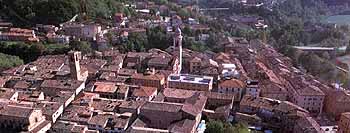
Urbania
The next stretch of the tour again heads up into mountain territory as it makes for Piobbico. Don't waste too much time in the small modern nucleus along the main road. Instead make for the higher end of town where you'll find a splendid castle and the borghetto, a cluster of crumbling medieval houses clinging like limpets to the hillside around it. Originally built in the 13thC by the ruling Brancaleoni family, the castle was given an elegant Renaissance facelift in the 1570s. After years of neglect, it has now being given a much deserved restoration - it is open to the public between June and September at weekends, but even when closed it's worth walking up to peer into the courtyard. The town is celebrated in Italy for being the home of the Club dei Brutti, an association for the world's downtrodden uglies - their motto reads "Ugliness is a virtue; beauty is slavery".
From Piobbico our route takes a picturesque return route via Acqualagna to Urbino to see Fermignano, a thriving small town just south of Urbino that warrants a brief stop to see the old village centre with its picturesque ancient bridge and solid tower by the river Candigliano. It also has an annual race with frogs in wheelbarrows on the first Sunday after Easter when the joint is really jumping.
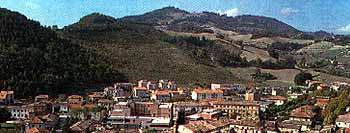
Fermignano
The countryside around is typical of the rolling hills backed by high mountains that surround Urbino. From here begins the winding climb back up to our starting point and a well-earned plate of soothing passatelli, Urbino's delicate pasta made from breadcrumbs, parmesan cheese and eggs and usually served in light broth.
Routes
Tour 1 - The Castles of Montefeltro
Tour 2 - From Paper to Stone
Tour 3 - The Vineyards of Verdicchio
Tour 4 - The Heartland of Le Marche
Tour 5 - In the Shadow of Monte Conero
Tour 6 - The Wild Mountains of the Sybil
Tour 7 - In the Footsteps of Ancient Rome
Tour 8 - Ascoli's Hidden Heritage
Tour 9 - Beside the Seaside
© Liberation Ventures Ltd.
|